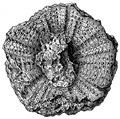The Echinoid Directory
Aeolopneustes Duncan & Sladen, 1882, p. 47
| Diagnostic Features |
|
|---|---|
| Distribution | Latest Palaeocene - Lower Eocene (Ranikot Limestone), Pakistan. |
| Name gender | neuter |
| Type | Aeolopneustes delorioli Duncan & Sladen, 1882, p. 48, by original designation. |
| Species Included |
|
| Classification and/or Status |
|
| Remarks |
|



